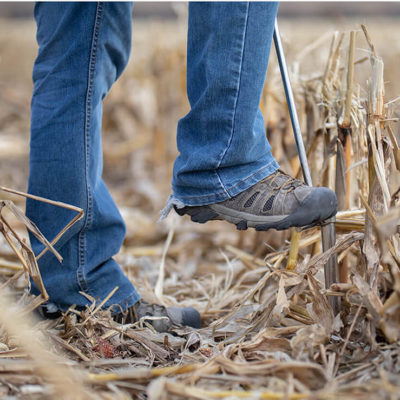Accurate soil carbon testing is essential for participating in carbon stock programs, and the requirements are fairly stringent and straightforward. Proper soil sampling for carbon can be achieved by taking into account depth and frequency as well as probe type and size.
Sample Collection Approach: Depth and Frequency
When sampling for bulk density, it’s important to consider whether to sample at a single depth or multiple depths. Sampling at multiple depths, such as 0-10 cm, 10-30 cm, or deeper, provides a more comprehensive picture of soil carbon stocks and bulk density across the soil profile. Both Verra and BCarbon protocols prioritize flexibility based on site-specific conditions. Verra suggests a depth range of 20-100 cm and requires enough samples to statistically represent carbon variability. Meanwhile, BCarbon commonly uses 30-100 cm depths and advises using statistical methods like power analysis to determine the number of samples required. Neither protocol sets an absolute number of samples. Both protocols emphasize achieving reliable and statistically sound data.
Sample Collection Approach: Composite Sampling
Composite sampling, where multiple subsamples are taken from different locations and mixed, is often used to get an accurate picture of a soils fertility. However, unlike other soil properties that can be assessed using composite samples, bulk density calculations are dependent on the exact volume and length of the soil core. This makes composite sampling challenging because bulk density is based on the mass and volume of a specific sample at a particular depth.
Combining soil from different locations or depths would obscure the accurate calculation of bulk density, which requires a known, fixed volume. To address this, if composite samples are desired, multiple bulk density samples must be taken separately at each depth and location, and the individual bulk densities averaged. This ensures that the calculations reflect the actual soil mass-to-volume ratio for each sample, maintaining accuracy in bulk density measurements.
A similar approach taken for fertility testing can also be used for bulk density sampling, where topography must be considered for representative results:
Grid sampling involves taking samples at regular intervals across a field to capture spatial variability.
Zonal samples are taken from different management zones within a field, such as areas with distinct soil types or management practices.
Random sampling is generally used for large, homogeneous fields to capture average soil carbon levels.
The chosen sampling approach should reflect the specific goals of the carbon stock assessment, whether for detailed field mapping or broader landscape analysis.
Sampling Approaches: Probe Type and Size
Large Probes
When measuring bulk density, the type and size of the soil probe can significantly impact the accuracy of the results. A larger probe (volume), typically 100 cm³ or more. Larger probes are generally preferred for bulk density measurements, especially in soils with high variability or coarse fragments. Larger probes, specifically ones with a wider opening, sample a greater volume of soil. This helps to reduce the influence of small-scale variations in soil structure, texture, and organic matter content. A larger probe makes the measurement more representative of the field conditions. Diagrams 1 through 3 show some of the different probes/augers used to sample for bulk density. This includes a simple cylinder, rubber mallet, and block of wood. The goal is capturing an intact, uniform sample (or samples) that accurately represent the site of interest.



Small Probes
Smaller probes, while easier to handle, are more prone to variability. Small probes may not capture the full range of soil properties, especially in heterogeneous soils. They can also be less effective in soils with large amounts of coarse fragments or organic matter. Because smaller samples might not adequately represent the bulk characteristics. Therefore, for accurate bulk density measurements larger probes are typically more reliable. This is especially true when coarse fragments or variability are a concern.
Once soil sampling for carbon is complete the samples are submitted to the lab. At the lab proper methods are applied to measure carbon and bulk density to calculate carbon stocks.




